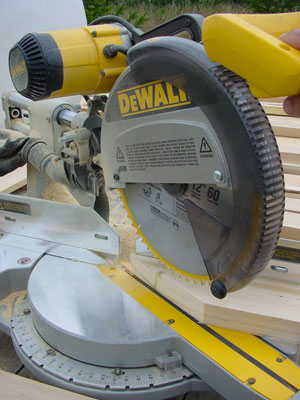If you could have only one power tool to help with home renovations, a mitre saw is the one to choose.  It’s the quickest way to become an expert at cutting everything from construction lumber to trim. Also called a chopsaw, these power tools make precise angled crosscuts easy, and there are three main types to choose from.
It’s the quickest way to become an expert at cutting everything from construction lumber to trim. Also called a chopsaw, these power tools make precise angled crosscuts easy, and there are three main types to choose from.
Simple mitre saws are built around a circular saw blade and motor that pivots up and down to make cuts. Lumber sits on a table that pivots one way or the other to allow angled cuts. Like all mitre saws, simple models are described by blade diameter, typically 10″ or 12″. Blade size matters since it relates directly to how wide a piece of wood you can cut. A 10″ diameter blade can cut a 2×6 at 90°, and a 12” blade can handle a 2×8. Crosscutting capacity gets smaller as the angle of a cut increases. A simple mitre saw make sense if you’re tooling up on a budget, or if you need a light saw that’s easy to carry. Simple mitre saws can only cut angles in one plane. More on this later.
Compound mitre saws are like simple mitre saws in that they let you pivot them downwards to complete a cut. But in addition to this, the entire blade and motor assembly tilts vertically. This allows the ability to make angled cuts in two directions, with just a single chopping action. This dual angle business is what the word “compound” means. You won’t use it all the time, but it’s nice to have for everything from big outdoor projects to interior trim jobs. Crosscutting capacity of a compound mitre saw is the same as a simple saw with the same blade diameter.

Choose a compound model if you’re okay with slightly more weight and a higher price tag, and want the ability to cut more complex angles.
Sliding compound mitre saws combine the features of the simple and compound saws with something different. The entire blade and motor assembly sits on rails or an articulated arm, so they can slide back and forth during a cut. This greatly increases the width of wood that can be cut for a given blade diameter. Most sliding compound mitre saws can crosscut material at least 12” wide, and that’s as wide as lumber gets. This makes the sliding compound mitre saw the most versatile of all models.
Regardless of the type of mitre saw you choose, don’t assume that it’s adjusted accurately right out of the box. Just because the marks on the saw say you’re cutting at 45º, 90º, or any other angle, doesn’t mean it’s actually so. Test your saw before trusting it.
Start by positioning the support table to make a simple 90º cut across a 1×4 or 1×6. Flip one of the halves of wood over, then bring the cut ends together with the edges of both pieces tight to the fence. Is there any gap? If any opening is there, it represents twice the error of the saw. Although different saws are adjusted differently (check your manual)—once you fine-tune the 90º angle properly, all other angles will be correct. Is your saw a compound model? If it is, repeat the cutting and flipping process to determine if vertical cuts are accurate, too.
One more thing. If your saw is adjusted accurately, and you find that window or door trim still doesn’t come together tightly at the corners, the error is probably in your building. Few corners are perfectly square, so expect to do a little adjustments as you work. If only buildings could be adjusted as easily as mitre saws.


